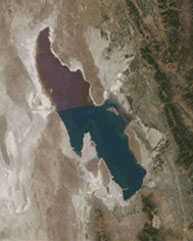|

This summer we had the opportunity to intern in the Baliga Lab at the Institute for Systems Biology (ISB). Our main goals were to help develop curriculum for the Bellevue School District and to gain further lab experience. In order to reach these goals we worked with our mentors Brad Moore, Claudia Ludwig and Ryan Gunhold to evaluate labs and see how they would work in a high school environment. We took initiative to gain more lab experience by working with Lee Pang on further investigations separate from our original assignment, and by reaching out to other members of the ISB community.
Our work this summer focused on developing experiments that dealt with Halobacteria (Halo) and it's response to environmental changes within the Great Salt Lake (GSL). The Salinity Lab was developed to represent the different enviornments that resulted from the seperation of the Northern and Southern arms of the lake. The construction of the causeway seperating the arms resulted in decreased water levels and differing salinity levels between the two sides, causing the North arm to be hyper saline and support the growth of Halo. Another difference that developed after the construction of the causeway was differing concentrations of toxic metals due to a concentrated metal solution leak from an industrial plant on the North arm.
The Metal Toxicity Lab simulated the metal solution leak in the Great Salt Lake and the effect of the metal solutions on the ecosystem. Halo was used in the experiment because it is one of the organisms that is found in the ecosystem of the Great Salt Lake.
 
Though these experiments mainly deal with the ecosystem of the Great Salt Lake, these scenarios can be applied to other
circumstances. Halo is used in these experiments as a model organism because it is easy to manipulate and grow in the labratory.
|